GCU Public Health: Article Analysis and Evaluation of Research Ethics
VerifiedAdded on 2022/10/11
|8
|2456
|46
Homework Assignment
AI Summary
This assignment involves an in-depth analysis of a research article titled "Understanding implementation and feasibility of tobacco cessation in routine primary care in Nepal: a mixed methods study" by Elsey et al. (2015). The study investigated the challenges and feasibility of implementing behavioral support interventions for tobacco cessation within primary care settings in Nepal. The analysis covers various aspects of the research, including the problem and purpose statements, research questions, hypotheses, variables, population, sample, and sampling methods. It details the data collection methods, which involved qualitative interviews, focus group discussions, and quantitative data analysis using SPSS. The assignment summarizes the study's results, highlighting the low identification of smokers, limited motivation among healthcare workers, and challenges in implementing the intervention. It also identifies the study's strengths, such as exploring challenges in low-income settings and using the Normalization Process Theory, along with limitations like difficulties in participatory approaches and follow-up issues. Furthermore, the assignment evaluates the ethical considerations of the study, addressing issues such as informed consent, privacy, confidentiality, and voluntary participation. It emphasizes the importance of ethical guidelines in research and provides a critical analysis of the study's adherence to these principles. The article analysis also identifies potential ethical concerns related to sampling, data collection, analysis, and publication, offering a comprehensive assessment of the research's ethical dimensions.
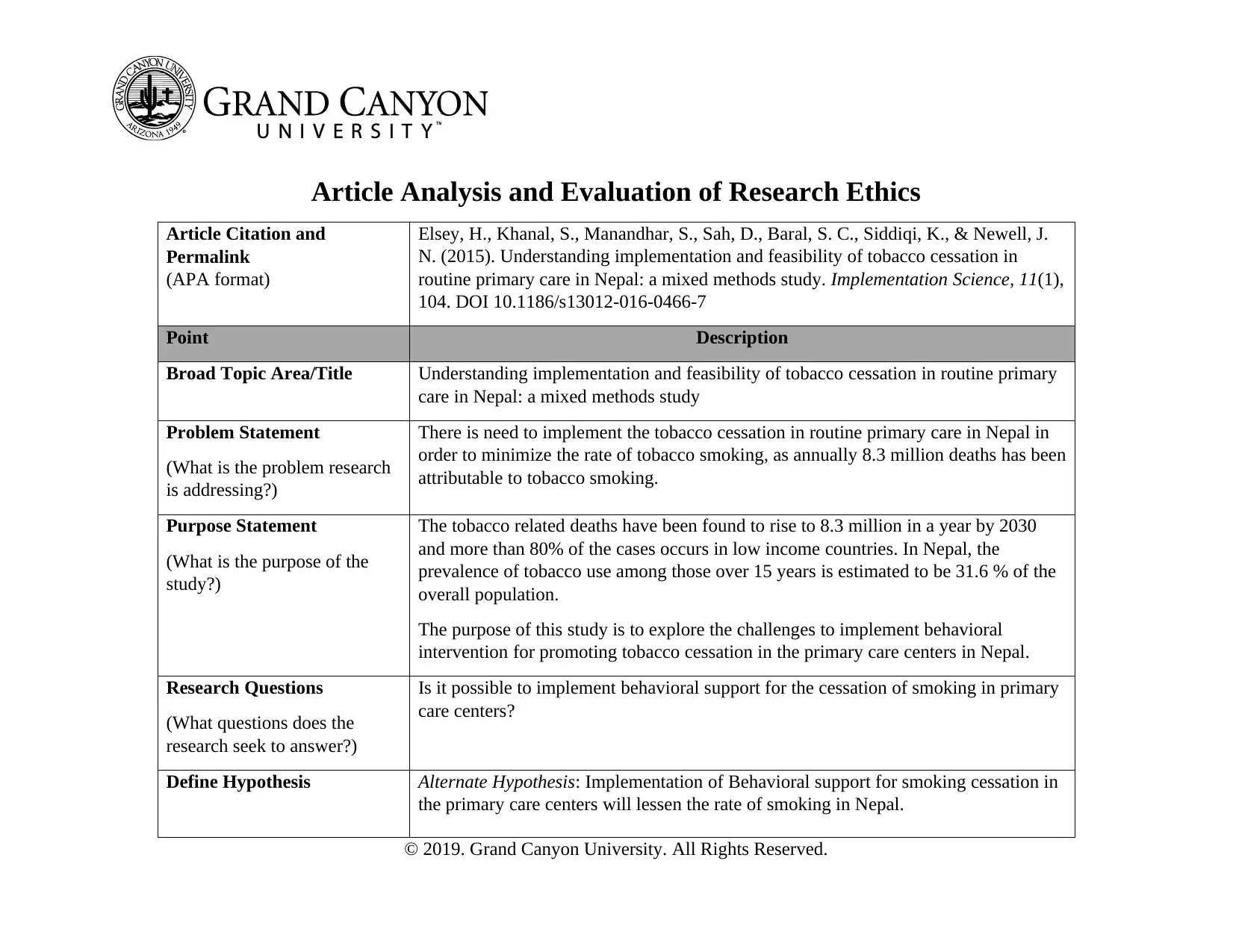
Article Analysis and Evaluation of Research Ethics
Article Citation and
Permalink
(APA format)
Elsey, H., Khanal, S., Manandhar, S., Sah, D., Baral, S. C., Siddiqi, K., & Newell, J.
N. (2015). Understanding implementation and feasibility of tobacco cessation in
routine primary care in Nepal: a mixed methods study. Implementation Science, 11(1),
104. DOI 10.1186/s13012-016-0466-7
Point Description
Broad Topic Area/Title Understanding implementation and feasibility of tobacco cessation in routine primary
care in Nepal: a mixed methods study
Problem Statement
(What is the problem research
is addressing?)
There is need to implement the tobacco cessation in routine primary care in Nepal in
order to minimize the rate of tobacco smoking, as annually 8.3 million deaths has been
attributable to tobacco smoking.
Purpose Statement
(What is the purpose of the
study?)
The tobacco related deaths have been found to rise to 8.3 million in a year by 2030
and more than 80% of the cases occurs in low income countries. In Nepal, the
prevalence of tobacco use among those over 15 years is estimated to be 31.6 % of the
overall population.
The purpose of this study is to explore the challenges to implement behavioral
intervention for promoting tobacco cessation in the primary care centers in Nepal.
Research Questions
(What questions does the
research seek to answer?)
Is it possible to implement behavioral support for the cessation of smoking in primary
care centers?
Define Hypothesis Alternate Hypothesis: Implementation of Behavioral support for smoking cessation in
the primary care centers will lessen the rate of smoking in Nepal.
© 2019. Grand Canyon University. All Rights Reserved.
Article Citation and
Permalink
(APA format)
Elsey, H., Khanal, S., Manandhar, S., Sah, D., Baral, S. C., Siddiqi, K., & Newell, J.
N. (2015). Understanding implementation and feasibility of tobacco cessation in
routine primary care in Nepal: a mixed methods study. Implementation Science, 11(1),
104. DOI 10.1186/s13012-016-0466-7
Point Description
Broad Topic Area/Title Understanding implementation and feasibility of tobacco cessation in routine primary
care in Nepal: a mixed methods study
Problem Statement
(What is the problem research
is addressing?)
There is need to implement the tobacco cessation in routine primary care in Nepal in
order to minimize the rate of tobacco smoking, as annually 8.3 million deaths has been
attributable to tobacco smoking.
Purpose Statement
(What is the purpose of the
study?)
The tobacco related deaths have been found to rise to 8.3 million in a year by 2030
and more than 80% of the cases occurs in low income countries. In Nepal, the
prevalence of tobacco use among those over 15 years is estimated to be 31.6 % of the
overall population.
The purpose of this study is to explore the challenges to implement behavioral
intervention for promoting tobacco cessation in the primary care centers in Nepal.
Research Questions
(What questions does the
research seek to answer?)
Is it possible to implement behavioral support for the cessation of smoking in primary
care centers?
Define Hypothesis Alternate Hypothesis: Implementation of Behavioral support for smoking cessation in
the primary care centers will lessen the rate of smoking in Nepal.
© 2019. Grand Canyon University. All Rights Reserved.
Paraphrase This Document
Need a fresh take? Get an instant paraphrase of this document with our AI Paraphraser
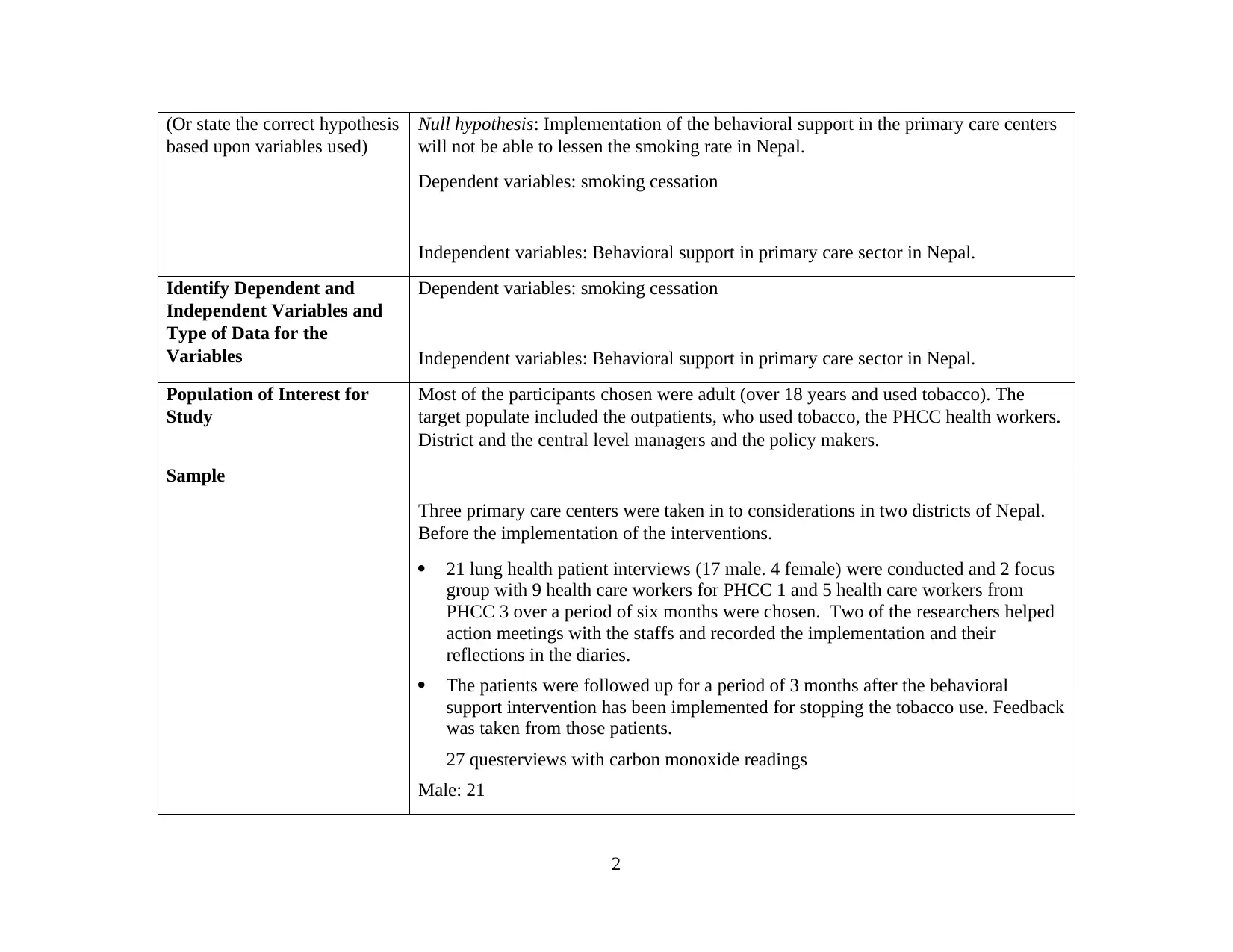
(Or state the correct hypothesis
based upon variables used)
Null hypothesis: Implementation of the behavioral support in the primary care centers
will not be able to lessen the smoking rate in Nepal.
Dependent variables: smoking cessation
Independent variables: Behavioral support in primary care sector in Nepal.
Identify Dependent and
Independent Variables and
Type of Data for the
Variables
Dependent variables: smoking cessation
Independent variables: Behavioral support in primary care sector in Nepal.
Population of Interest for
Study
Most of the participants chosen were adult (over 18 years and used tobacco). The
target populate included the outpatients, who used tobacco, the PHCC health workers.
District and the central level managers and the policy makers.
Sample
Three primary care centers were taken in to considerations in two districts of Nepal.
Before the implementation of the interventions.
21 lung health patient interviews (17 male. 4 female) were conducted and 2 focus
group with 9 health care workers for PHCC 1 and 5 health care workers from
PHCC 3 over a period of six months were chosen. Two of the researchers helped
action meetings with the staffs and recorded the implementation and their
reflections in the diaries.
The patients were followed up for a period of 3 months after the behavioral
support intervention has been implemented for stopping the tobacco use. Feedback
was taken from those patients.
27 questerviews with carbon monoxide readings
Male: 21
2
based upon variables used)
Null hypothesis: Implementation of the behavioral support in the primary care centers
will not be able to lessen the smoking rate in Nepal.
Dependent variables: smoking cessation
Independent variables: Behavioral support in primary care sector in Nepal.
Identify Dependent and
Independent Variables and
Type of Data for the
Variables
Dependent variables: smoking cessation
Independent variables: Behavioral support in primary care sector in Nepal.
Population of Interest for
Study
Most of the participants chosen were adult (over 18 years and used tobacco). The
target populate included the outpatients, who used tobacco, the PHCC health workers.
District and the central level managers and the policy makers.
Sample
Three primary care centers were taken in to considerations in two districts of Nepal.
Before the implementation of the interventions.
21 lung health patient interviews (17 male. 4 female) were conducted and 2 focus
group with 9 health care workers for PHCC 1 and 5 health care workers from
PHCC 3 over a period of six months were chosen. Two of the researchers helped
action meetings with the staffs and recorded the implementation and their
reflections in the diaries.
The patients were followed up for a period of 3 months after the behavioral
support intervention has been implemented for stopping the tobacco use. Feedback
was taken from those patients.
27 questerviews with carbon monoxide readings
Male: 21
2
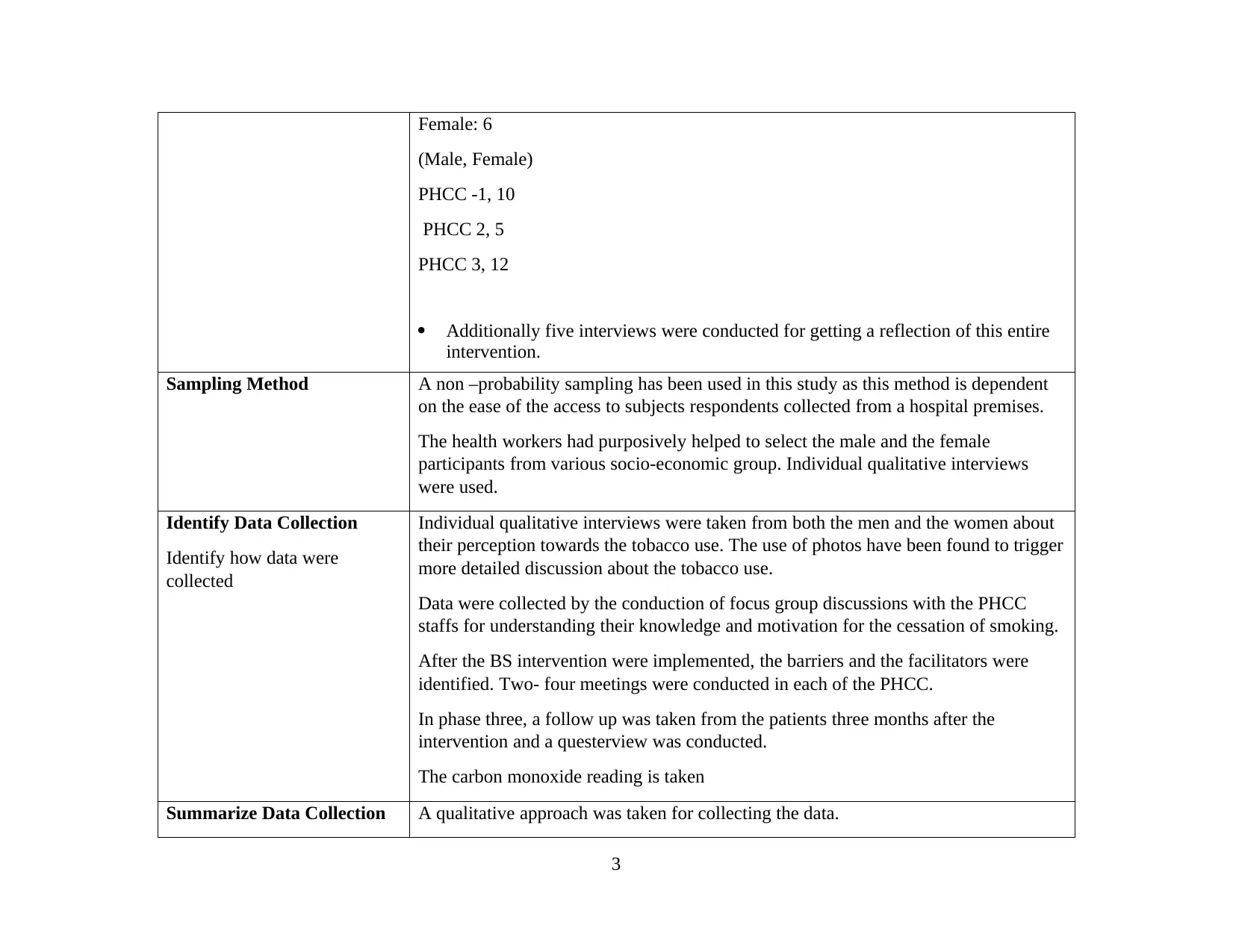
Female: 6
(Male, Female)
PHCC -1, 10
PHCC 2, 5
PHCC 3, 12
Additionally five interviews were conducted for getting a reflection of this entire
intervention.
Sampling Method A non –probability sampling has been used in this study as this method is dependent
on the ease of the access to subjects respondents collected from a hospital premises.
The health workers had purposively helped to select the male and the female
participants from various socio-economic group. Individual qualitative interviews
were used.
Identify Data Collection
Identify how data were
collected
Individual qualitative interviews were taken from both the men and the women about
their perception towards the tobacco use. The use of photos have been found to trigger
more detailed discussion about the tobacco use.
Data were collected by the conduction of focus group discussions with the PHCC
staffs for understanding their knowledge and motivation for the cessation of smoking.
After the BS intervention were implemented, the barriers and the facilitators were
identified. Two- four meetings were conducted in each of the PHCC.
In phase three, a follow up was taken from the patients three months after the
intervention and a questerview was conducted.
The carbon monoxide reading is taken
Summarize Data Collection A qualitative approach was taken for collecting the data.
3
(Male, Female)
PHCC -1, 10
PHCC 2, 5
PHCC 3, 12
Additionally five interviews were conducted for getting a reflection of this entire
intervention.
Sampling Method A non –probability sampling has been used in this study as this method is dependent
on the ease of the access to subjects respondents collected from a hospital premises.
The health workers had purposively helped to select the male and the female
participants from various socio-economic group. Individual qualitative interviews
were used.
Identify Data Collection
Identify how data were
collected
Individual qualitative interviews were taken from both the men and the women about
their perception towards the tobacco use. The use of photos have been found to trigger
more detailed discussion about the tobacco use.
Data were collected by the conduction of focus group discussions with the PHCC
staffs for understanding their knowledge and motivation for the cessation of smoking.
After the BS intervention were implemented, the barriers and the facilitators were
identified. Two- four meetings were conducted in each of the PHCC.
In phase three, a follow up was taken from the patients three months after the
intervention and a questerview was conducted.
The carbon monoxide reading is taken
Summarize Data Collection A qualitative approach was taken for collecting the data.
3
⊘ This is a preview!⊘
Do you want full access?
Subscribe today to unlock all pages.

Trusted by 1+ million students worldwide
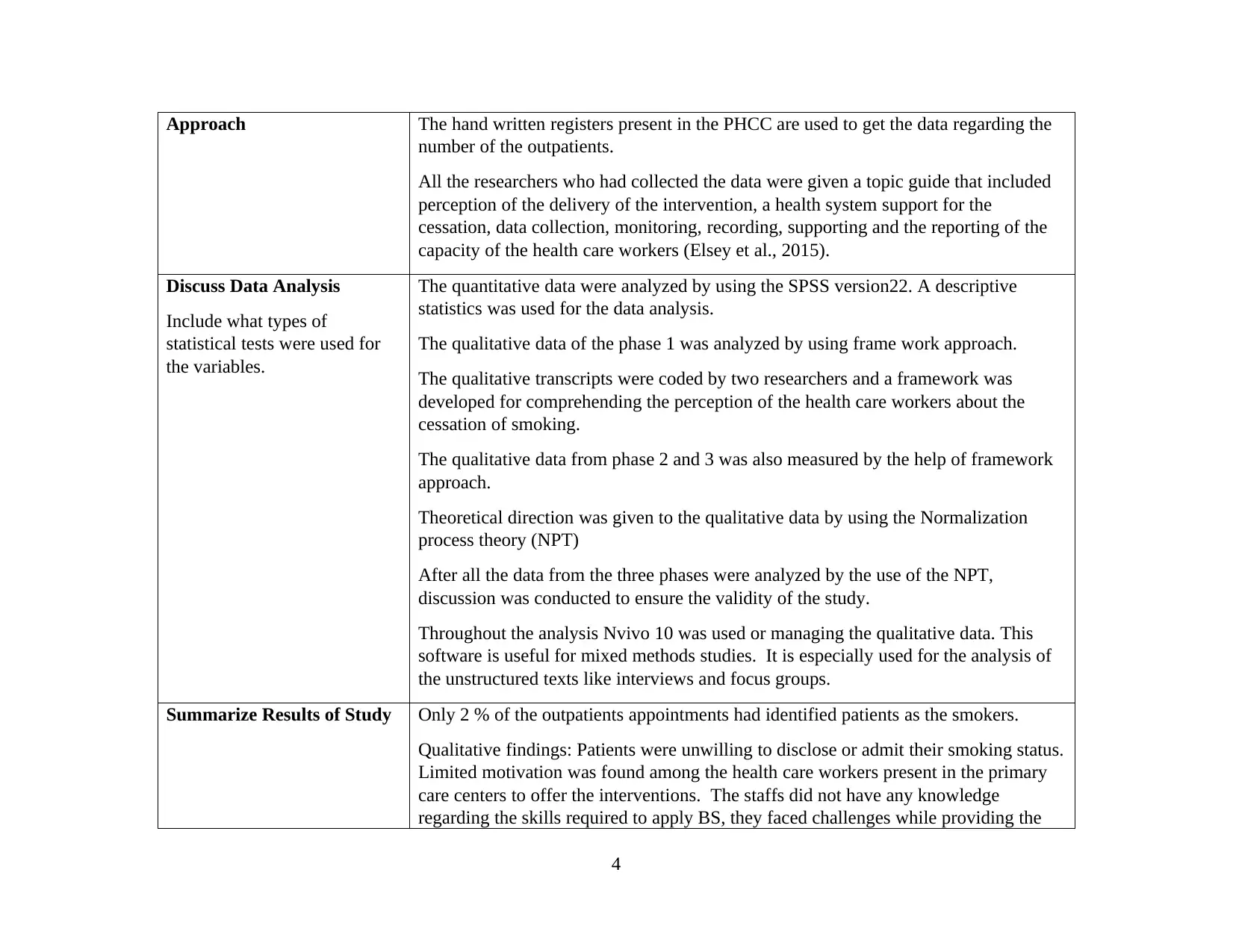
Approach The hand written registers present in the PHCC are used to get the data regarding the
number of the outpatients.
All the researchers who had collected the data were given a topic guide that included
perception of the delivery of the intervention, a health system support for the
cessation, data collection, monitoring, recording, supporting and the reporting of the
capacity of the health care workers (Elsey et al., 2015).
Discuss Data Analysis
Include what types of
statistical tests were used for
the variables.
The quantitative data were analyzed by using the SPSS version22. A descriptive
statistics was used for the data analysis.
The qualitative data of the phase 1 was analyzed by using frame work approach.
The qualitative transcripts were coded by two researchers and a framework was
developed for comprehending the perception of the health care workers about the
cessation of smoking.
The qualitative data from phase 2 and 3 was also measured by the help of framework
approach.
Theoretical direction was given to the qualitative data by using the Normalization
process theory (NPT)
After all the data from the three phases were analyzed by the use of the NPT,
discussion was conducted to ensure the validity of the study.
Throughout the analysis Nvivo 10 was used or managing the qualitative data. This
software is useful for mixed methods studies. It is especially used for the analysis of
the unstructured texts like interviews and focus groups.
Summarize Results of Study Only 2 % of the outpatients appointments had identified patients as the smokers.
Qualitative findings: Patients were unwilling to disclose or admit their smoking status.
Limited motivation was found among the health care workers present in the primary
care centers to offer the interventions. The staffs did not have any knowledge
regarding the skills required to apply BS, they faced challenges while providing the
4
number of the outpatients.
All the researchers who had collected the data were given a topic guide that included
perception of the delivery of the intervention, a health system support for the
cessation, data collection, monitoring, recording, supporting and the reporting of the
capacity of the health care workers (Elsey et al., 2015).
Discuss Data Analysis
Include what types of
statistical tests were used for
the variables.
The quantitative data were analyzed by using the SPSS version22. A descriptive
statistics was used for the data analysis.
The qualitative data of the phase 1 was analyzed by using frame work approach.
The qualitative transcripts were coded by two researchers and a framework was
developed for comprehending the perception of the health care workers about the
cessation of smoking.
The qualitative data from phase 2 and 3 was also measured by the help of framework
approach.
Theoretical direction was given to the qualitative data by using the Normalization
process theory (NPT)
After all the data from the three phases were analyzed by the use of the NPT,
discussion was conducted to ensure the validity of the study.
Throughout the analysis Nvivo 10 was used or managing the qualitative data. This
software is useful for mixed methods studies. It is especially used for the analysis of
the unstructured texts like interviews and focus groups.
Summarize Results of Study Only 2 % of the outpatients appointments had identified patients as the smokers.
Qualitative findings: Patients were unwilling to disclose or admit their smoking status.
Limited motivation was found among the health care workers present in the primary
care centers to offer the interventions. The staffs did not have any knowledge
regarding the skills required to apply BS, they faced challenges while providing the
4
Paraphrase This Document
Need a fresh take? Get an instant paraphrase of this document with our AI Paraphraser
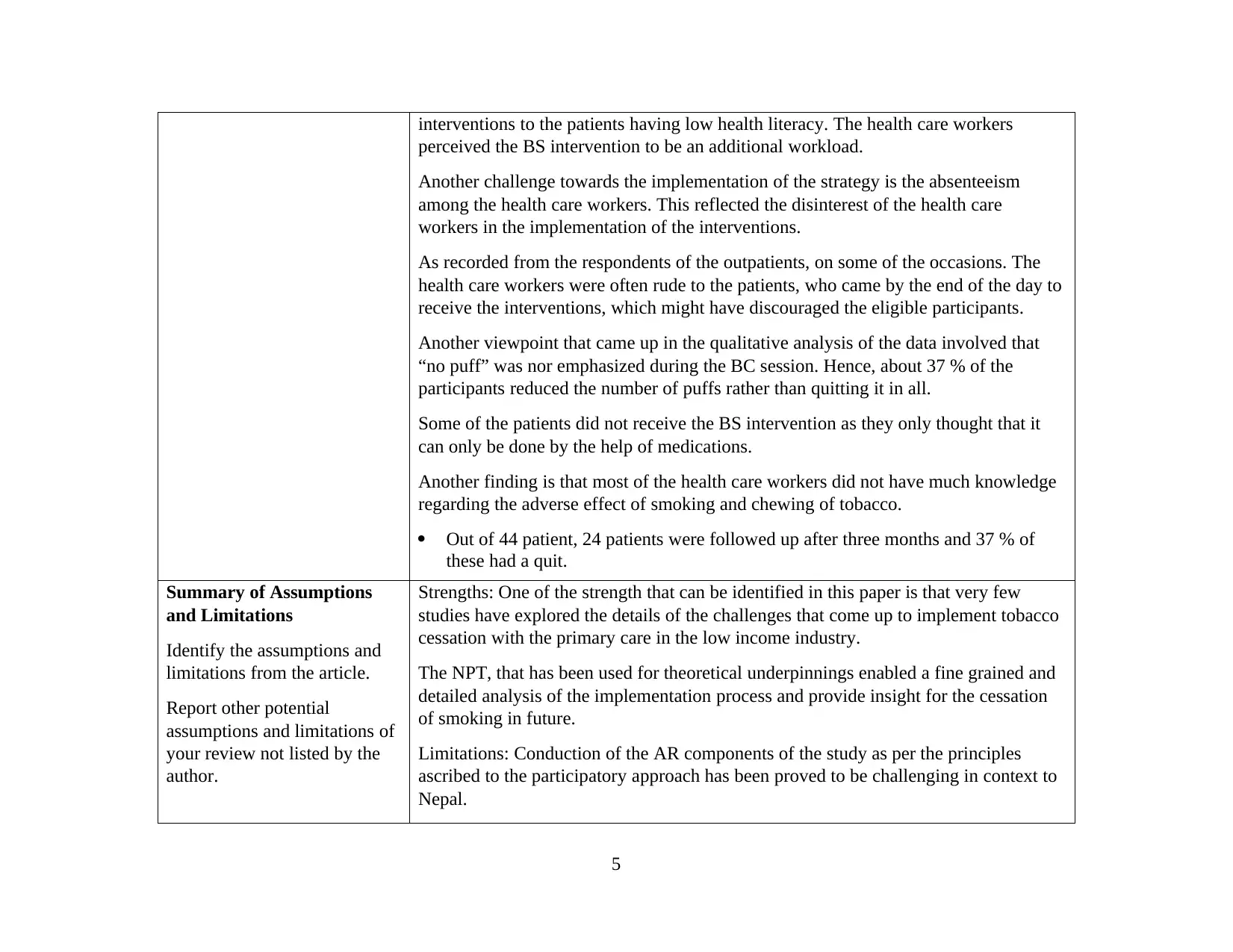
interventions to the patients having low health literacy. The health care workers
perceived the BS intervention to be an additional workload.
Another challenge towards the implementation of the strategy is the absenteeism
among the health care workers. This reflected the disinterest of the health care
workers in the implementation of the interventions.
As recorded from the respondents of the outpatients, on some of the occasions. The
health care workers were often rude to the patients, who came by the end of the day to
receive the interventions, which might have discouraged the eligible participants.
Another viewpoint that came up in the qualitative analysis of the data involved that
“no puff” was nor emphasized during the BC session. Hence, about 37 % of the
participants reduced the number of puffs rather than quitting it in all.
Some of the patients did not receive the BS intervention as they only thought that it
can only be done by the help of medications.
Another finding is that most of the health care workers did not have much knowledge
regarding the adverse effect of smoking and chewing of tobacco.
Out of 44 patient, 24 patients were followed up after three months and 37 % of
these had a quit.
Summary of Assumptions
and Limitations
Identify the assumptions and
limitations from the article.
Report other potential
assumptions and limitations of
your review not listed by the
author.
Strengths: One of the strength that can be identified in this paper is that very few
studies have explored the details of the challenges that come up to implement tobacco
cessation with the primary care in the low income industry.
The NPT, that has been used for theoretical underpinnings enabled a fine grained and
detailed analysis of the implementation process and provide insight for the cessation
of smoking in future.
Limitations: Conduction of the AR components of the study as per the principles
ascribed to the participatory approach has been proved to be challenging in context to
Nepal.
5
perceived the BS intervention to be an additional workload.
Another challenge towards the implementation of the strategy is the absenteeism
among the health care workers. This reflected the disinterest of the health care
workers in the implementation of the interventions.
As recorded from the respondents of the outpatients, on some of the occasions. The
health care workers were often rude to the patients, who came by the end of the day to
receive the interventions, which might have discouraged the eligible participants.
Another viewpoint that came up in the qualitative analysis of the data involved that
“no puff” was nor emphasized during the BC session. Hence, about 37 % of the
participants reduced the number of puffs rather than quitting it in all.
Some of the patients did not receive the BS intervention as they only thought that it
can only be done by the help of medications.
Another finding is that most of the health care workers did not have much knowledge
regarding the adverse effect of smoking and chewing of tobacco.
Out of 44 patient, 24 patients were followed up after three months and 37 % of
these had a quit.
Summary of Assumptions
and Limitations
Identify the assumptions and
limitations from the article.
Report other potential
assumptions and limitations of
your review not listed by the
author.
Strengths: One of the strength that can be identified in this paper is that very few
studies have explored the details of the challenges that come up to implement tobacco
cessation with the primary care in the low income industry.
The NPT, that has been used for theoretical underpinnings enabled a fine grained and
detailed analysis of the implementation process and provide insight for the cessation
of smoking in future.
Limitations: Conduction of the AR components of the study as per the principles
ascribed to the participatory approach has been proved to be challenging in context to
Nepal.
5
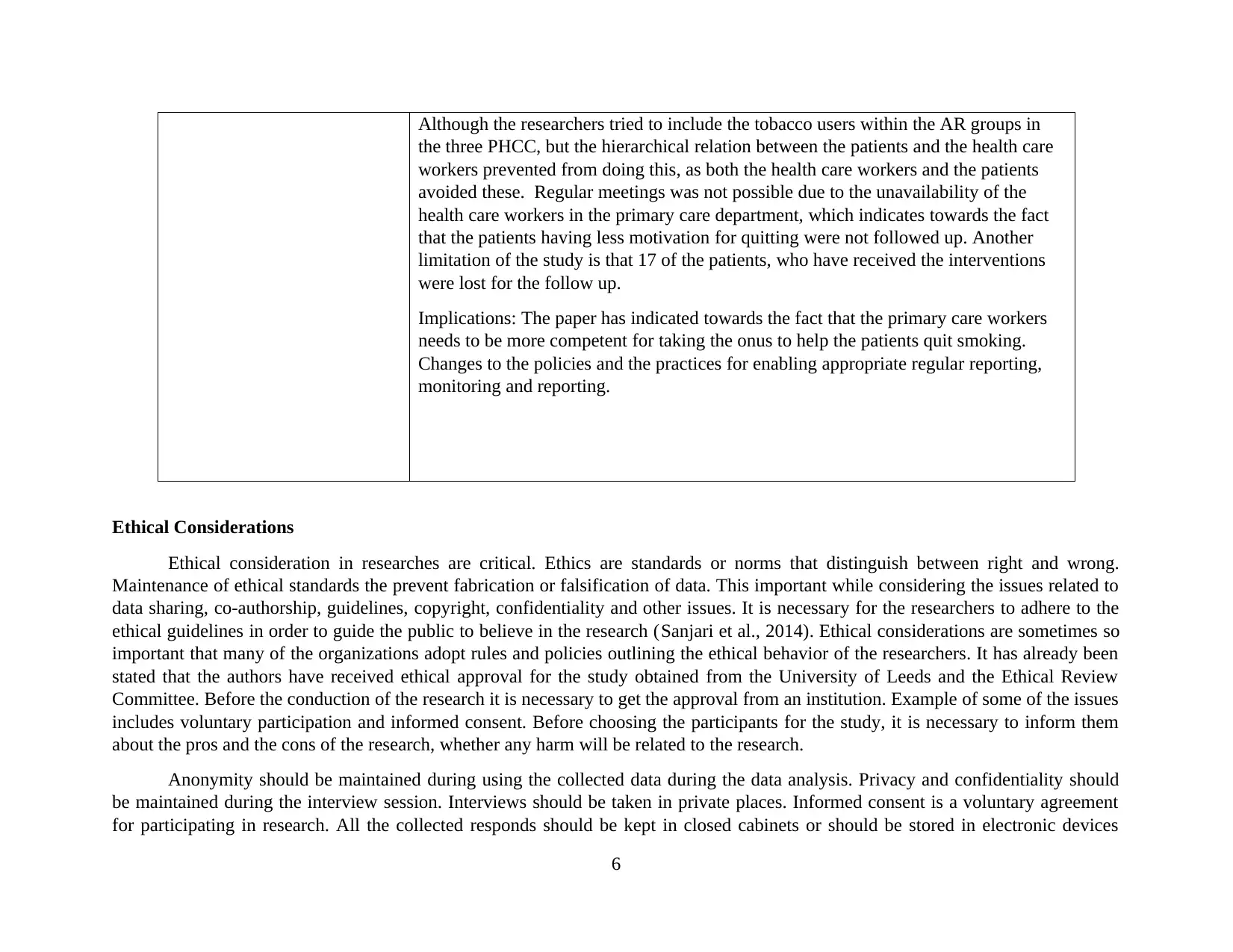
Although the researchers tried to include the tobacco users within the AR groups in
the three PHCC, but the hierarchical relation between the patients and the health care
workers prevented from doing this, as both the health care workers and the patients
avoided these. Regular meetings was not possible due to the unavailability of the
health care workers in the primary care department, which indicates towards the fact
that the patients having less motivation for quitting were not followed up. Another
limitation of the study is that 17 of the patients, who have received the interventions
were lost for the follow up.
Implications: The paper has indicated towards the fact that the primary care workers
needs to be more competent for taking the onus to help the patients quit smoking.
Changes to the policies and the practices for enabling appropriate regular reporting,
monitoring and reporting.
Ethical Considerations
Ethical consideration in researches are critical. Ethics are standards or norms that distinguish between right and wrong.
Maintenance of ethical standards the prevent fabrication or falsification of data. This important while considering the issues related to
data sharing, co-authorship, guidelines, copyright, confidentiality and other issues. It is necessary for the researchers to adhere to the
ethical guidelines in order to guide the public to believe in the research (Sanjari et al., 2014). Ethical considerations are sometimes so
important that many of the organizations adopt rules and policies outlining the ethical behavior of the researchers. It has already been
stated that the authors have received ethical approval for the study obtained from the University of Leeds and the Ethical Review
Committee. Before the conduction of the research it is necessary to get the approval from an institution. Example of some of the issues
includes voluntary participation and informed consent. Before choosing the participants for the study, it is necessary to inform them
about the pros and the cons of the research, whether any harm will be related to the research.
Anonymity should be maintained during using the collected data during the data analysis. Privacy and confidentiality should
be maintained during the interview session. Interviews should be taken in private places. Informed consent is a voluntary agreement
for participating in research. All the collected responds should be kept in closed cabinets or should be stored in electronic devices
6
the three PHCC, but the hierarchical relation between the patients and the health care
workers prevented from doing this, as both the health care workers and the patients
avoided these. Regular meetings was not possible due to the unavailability of the
health care workers in the primary care department, which indicates towards the fact
that the patients having less motivation for quitting were not followed up. Another
limitation of the study is that 17 of the patients, who have received the interventions
were lost for the follow up.
Implications: The paper has indicated towards the fact that the primary care workers
needs to be more competent for taking the onus to help the patients quit smoking.
Changes to the policies and the practices for enabling appropriate regular reporting,
monitoring and reporting.
Ethical Considerations
Ethical consideration in researches are critical. Ethics are standards or norms that distinguish between right and wrong.
Maintenance of ethical standards the prevent fabrication or falsification of data. This important while considering the issues related to
data sharing, co-authorship, guidelines, copyright, confidentiality and other issues. It is necessary for the researchers to adhere to the
ethical guidelines in order to guide the public to believe in the research (Sanjari et al., 2014). Ethical considerations are sometimes so
important that many of the organizations adopt rules and policies outlining the ethical behavior of the researchers. It has already been
stated that the authors have received ethical approval for the study obtained from the University of Leeds and the Ethical Review
Committee. Before the conduction of the research it is necessary to get the approval from an institution. Example of some of the issues
includes voluntary participation and informed consent. Before choosing the participants for the study, it is necessary to inform them
about the pros and the cons of the research, whether any harm will be related to the research.
Anonymity should be maintained during using the collected data during the data analysis. Privacy and confidentiality should
be maintained during the interview session. Interviews should be taken in private places. Informed consent is a voluntary agreement
for participating in research. All the collected responds should be kept in closed cabinets or should be stored in electronic devices
6
⊘ This is a preview!⊘
Do you want full access?
Subscribe today to unlock all pages.

Trusted by 1+ million students worldwide
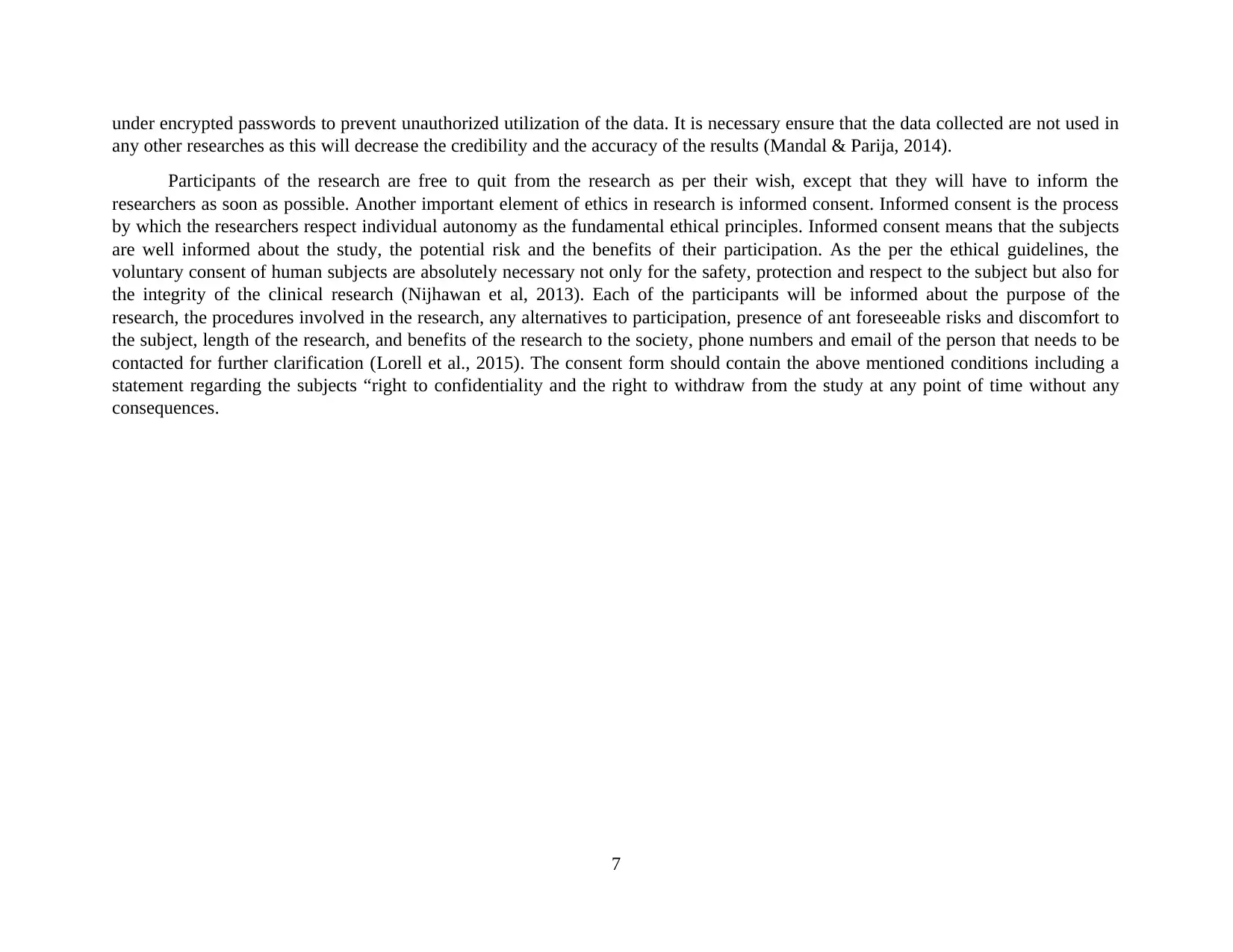
under encrypted passwords to prevent unauthorized utilization of the data. It is necessary ensure that the data collected are not used in
any other researches as this will decrease the credibility and the accuracy of the results (Mandal & Parija, 2014).
Participants of the research are free to quit from the research as per their wish, except that they will have to inform the
researchers as soon as possible. Another important element of ethics in research is informed consent. Informed consent is the process
by which the researchers respect individual autonomy as the fundamental ethical principles. Informed consent means that the subjects
are well informed about the study, the potential risk and the benefits of their participation. As the per the ethical guidelines, the
voluntary consent of human subjects are absolutely necessary not only for the safety, protection and respect to the subject but also for
the integrity of the clinical research (Nijhawan et al, 2013). Each of the participants will be informed about the purpose of the
research, the procedures involved in the research, any alternatives to participation, presence of ant foreseeable risks and discomfort to
the subject, length of the research, and benefits of the research to the society, phone numbers and email of the person that needs to be
contacted for further clarification (Lorell et al., 2015). The consent form should contain the above mentioned conditions including a
statement regarding the subjects “right to confidentiality and the right to withdraw from the study at any point of time without any
consequences.
7
any other researches as this will decrease the credibility and the accuracy of the results (Mandal & Parija, 2014).
Participants of the research are free to quit from the research as per their wish, except that they will have to inform the
researchers as soon as possible. Another important element of ethics in research is informed consent. Informed consent is the process
by which the researchers respect individual autonomy as the fundamental ethical principles. Informed consent means that the subjects
are well informed about the study, the potential risk and the benefits of their participation. As the per the ethical guidelines, the
voluntary consent of human subjects are absolutely necessary not only for the safety, protection and respect to the subject but also for
the integrity of the clinical research (Nijhawan et al, 2013). Each of the participants will be informed about the purpose of the
research, the procedures involved in the research, any alternatives to participation, presence of ant foreseeable risks and discomfort to
the subject, length of the research, and benefits of the research to the society, phone numbers and email of the person that needs to be
contacted for further clarification (Lorell et al., 2015). The consent form should contain the above mentioned conditions including a
statement regarding the subjects “right to confidentiality and the right to withdraw from the study at any point of time without any
consequences.
7
Paraphrase This Document
Need a fresh take? Get an instant paraphrase of this document with our AI Paraphraser
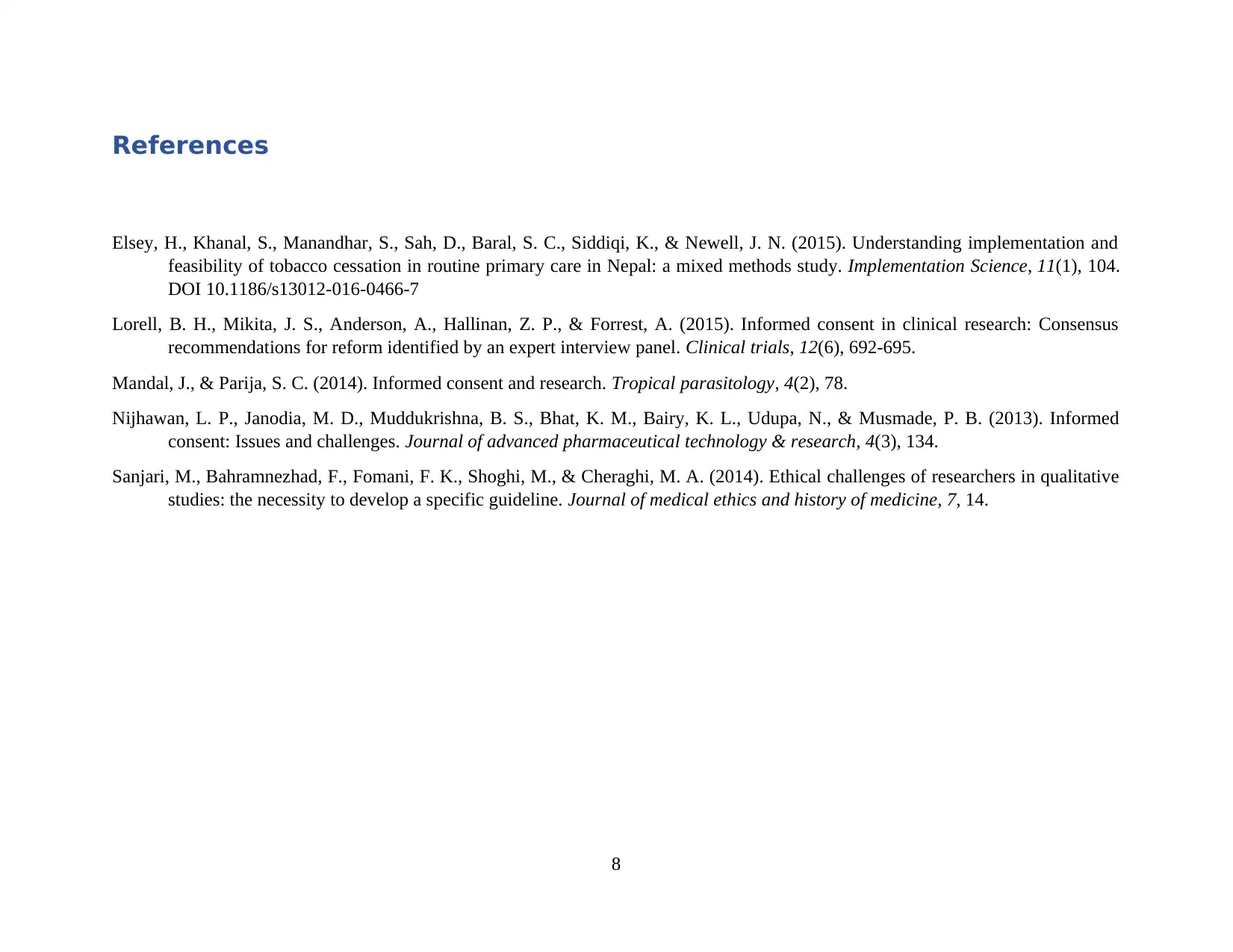
References
Elsey, H., Khanal, S., Manandhar, S., Sah, D., Baral, S. C., Siddiqi, K., & Newell, J. N. (2015). Understanding implementation and
feasibility of tobacco cessation in routine primary care in Nepal: a mixed methods study. Implementation Science, 11(1), 104.
DOI 10.1186/s13012-016-0466-7
Lorell, B. H., Mikita, J. S., Anderson, A., Hallinan, Z. P., & Forrest, A. (2015). Informed consent in clinical research: Consensus
recommendations for reform identified by an expert interview panel. Clinical trials, 12(6), 692-695.
Mandal, J., & Parija, S. C. (2014). Informed consent and research. Tropical parasitology, 4(2), 78.
Nijhawan, L. P., Janodia, M. D., Muddukrishna, B. S., Bhat, K. M., Bairy, K. L., Udupa, N., & Musmade, P. B. (2013). Informed
consent: Issues and challenges. Journal of advanced pharmaceutical technology & research, 4(3), 134.
Sanjari, M., Bahramnezhad, F., Fomani, F. K., Shoghi, M., & Cheraghi, M. A. (2014). Ethical challenges of researchers in qualitative
studies: the necessity to develop a specific guideline. Journal of medical ethics and history of medicine, 7, 14.
8
Elsey, H., Khanal, S., Manandhar, S., Sah, D., Baral, S. C., Siddiqi, K., & Newell, J. N. (2015). Understanding implementation and
feasibility of tobacco cessation in routine primary care in Nepal: a mixed methods study. Implementation Science, 11(1), 104.
DOI 10.1186/s13012-016-0466-7
Lorell, B. H., Mikita, J. S., Anderson, A., Hallinan, Z. P., & Forrest, A. (2015). Informed consent in clinical research: Consensus
recommendations for reform identified by an expert interview panel. Clinical trials, 12(6), 692-695.
Mandal, J., & Parija, S. C. (2014). Informed consent and research. Tropical parasitology, 4(2), 78.
Nijhawan, L. P., Janodia, M. D., Muddukrishna, B. S., Bhat, K. M., Bairy, K. L., Udupa, N., & Musmade, P. B. (2013). Informed
consent: Issues and challenges. Journal of advanced pharmaceutical technology & research, 4(3), 134.
Sanjari, M., Bahramnezhad, F., Fomani, F. K., Shoghi, M., & Cheraghi, M. A. (2014). Ethical challenges of researchers in qualitative
studies: the necessity to develop a specific guideline. Journal of medical ethics and history of medicine, 7, 14.
8
1 out of 8
Related Documents
Your All-in-One AI-Powered Toolkit for Academic Success.
+13062052269
info@desklib.com
Available 24*7 on WhatsApp / Email
![[object Object]](/_next/static/media/star-bottom.7253800d.svg)
Unlock your academic potential
Copyright © 2020–2025 A2Z Services. All Rights Reserved. Developed and managed by ZUCOL.





